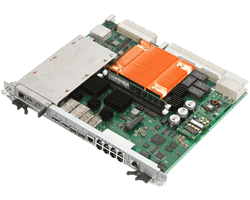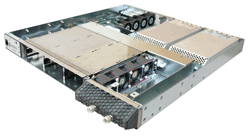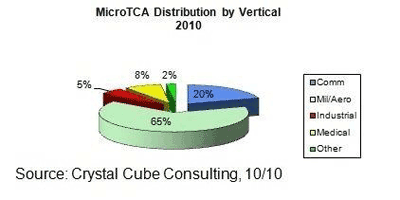ATCA/MicroTCA compute systems: Reporting for duty
Originally developed as a next-gen open platform for the telecom industry, ATCA’s versatility, scalability, and large ecosystem of products is helping it win a growing share of MIL/Aero computing applications
BY LEE GOLDBERG
Although it took nearly five years after the debut of the Advanced Telecom Computing Architecture (AdvancedTCA) specification, products based on this versatile standard are finally beginning to enjoy a substantial presence in the risk-averse mil/aero market. ATCA’s growing popularity is not surprising since the telecom industry for which the standard was developed shares the military electronics community’s need for high levels of performance, reliability, scalability, and affordability.
While ATCA and its compact cousin MicroTCA have already found many applications in many non-combat roles, there is growing interest in products that conform to the ATCA standard’s recent revisions that give it the enhanced cooling capabilities and ruggedness required for battlefield conditions (see Fig. 1 ).

Fig. 1. The dramatic “barge-testing” program conducted by Northrop Grumman demonstrated that ATCA equipment is rugged enough to meet the MIL-S-901D Heavyweight Shock Test requirements for deployment as shipboard systems. (Photographs courtesy of National Technical Systems in Rustburg, VA)
ATCA’s journey to Mil-readiness
“Some of ATCA’s slow acceptance has been due to VME/VME-64 bus and CompactPCI technologies’ mature pricing structures and long history in mil/aero applications that allowed them to dominate the Mil computing space until now,” says Ernie Bergstrom, Principal and Founder of Crystal Cube Consulting. This has gradually changed he past few years” as the higher performance levels, improved standardization and steadily declining cost of ATCA/MicroTCA systems are finally beginning to overcome that inertia,” he concluded.
Products based on the larger ATCA form factor that meet Mil specs for environmental, vibration and mechanical ruggedness have been available for some time. This, and the now-famous “barge tests” conducted by Northrop-Grumman (see Fig. 1) have contributed to the general consensus that it enjoys a high technology readiness level (TRL) rating.
Shreekant Raivadera, Marketing Communications Manager at Emerson Network Power says that ATCA is perceived as having a TRL of 7, indicating that it is mature, stable and available. He added that, with the successful deployment of ATCA in many demanding non-combat roles, he expects the technology to quickly move to level 8 (the level where equipment is actually deployed and “being shot at”).
It’s easy to see then, why ATCA systems are finding lots of applications in network infrastructures for communications, intelligence, reconnaissance, battle assessment and satellite communications. The high bandwidth and efficient form factor of ATCA’s mezzanine cards also makes them an ideal platform for the arrays of DSPs and FPGAs that perform the heavy signal processing tasks in radar systems, wireless base stations and software radios.
For example, BAE Systems is using the ATCA computing platform as the basis for the next generation Mission Computer System Suite for the Navy's P-8A Multimission Maritime Aircraft (MMA), a replacement for the venerable P-3 Orion. The ruggedized ATCA-processing platform allows BAE to produce a system that can be readily configured to meet the general purpose, I/O, video, voice, and graphics processing needs for modern military battle management requirements. In addition, systems based on ATCA are under evaluation for programs such as CANES (Consolidated Afloat Networks and Enterprise Services).
To meet the extreme bandwidth demands of these advanced applications, designers are turning to the next generation of 40-Gbit/s-capable chassis, line cards and switches being introduced by Emerson and other leading manufacturers. As part of this evolution, Emerson has been shipping chassis with 40G-capable backplanes for nearly two years and introduced its first 40-Gbit/s switch blades in June (see Fig. 2 ).
Emerson’s Raivadera says the company expects to build its first commercially-available 40G line cards as soon as the transceiver chips and packet processors capable of supporting the new line rate become available — most likely in mid-to-late 2011. Meanwhile development is underway for processor blades (primarily based on Intel’s Xenon family) and application software that can work comfortably in a 40Gbps environment.

Fig. 2. Combining Mil-grade ruggedness with 40Gbbps backplane capacity, products like Emerson Power Systems’ ATCA-F140-A1 40-Gbit/s ATCA switch blade will form the backbone of next-gen multimedia defense networks.
MicroATCA plays catch up
Based on the 73.8 x 181.5-mm cards and electrical interface of the Advanced Mezzanine Card [AMC]used by ATCA carrier cards, MicroTCA was originally developed to support “edge” applications in telecom networks. Its compact 2U form factor and high-capacity backplane (up to 21 lanes of 2.5-Gbit/s SerDes per card) makes it an attractive solution for packing lots of processing power into space-constrained field applications such as avionics, targeting, and acquisition, and vehicle-based computer systems that are vital to the “mobile warfighter.”
These same attributes make it appealing for mobile communications centers, cellular and WiFi/WiMAX-based field base stations, and other key elements of net-centric combat systems. There are, however, several significant challenges that must be met before MicroTCA products can be considered battle ready.
Most of the issues standing between MicroTCA and the battlefield are related to stringent Mil-level mechanical and thermal requirements. The original specification released in 2006 was adequate for stationary applications but did not secure the system’s cards sufficiently to endure the shock and vibration routinely encountered in vehicle-mounted and portable equipment.
PICMIG attempted to address these shortcomings with MTCA.1 “Rugged MicroTCA” (ratified in mid- 2009) and MTCA.2 “Hardened air cooled MicroTCA” which provide improved resistance to severe temperature, shock, vibration, and humidity and specify a chassis and connector system robust enough for field service. Unfortunately, MTCA.2’s forced air cooling is still impractical to operate in field conditions where dust, salt spray or other air contaminants are a routine fact of life. This will change once the MTCA.3 “Hardened conduction-cooled MicroTCA” specification is finally ratified later this year or in early 2011. MTCA.3’s updated mechanical specification houses the AMC inside a metal “clamshell” with wedge locks that provide both mechanical support for the board and a conductive thermal dissipation path through the chassis.

Fig. 3. MTCA.0-compliant products like Performance Technologies’ AMP5071 MicroTCA system are finding many roles in noncombat military systems. Performance Technology has also teamed Dawn VME, to use their MicroTCA cards in with Dawn’s ruggedized chassis to provide an off-the-shelf system that’s suitable for both manned and unmanned airborne combat applications.
Despite MicroTCA’s growing pains, MicroTCA.0 is still finding useful applications in less noncombat settings where high-performance compute systems are required for data and network systems, according to Tony Romero, Senior Product Manager at performance Technologies. To address the many applications that don’t require the significant added cost of MTCA compliance, Performance Technologies teamed with Dawn VME to produce a MTCA.1-rated system using their AMC blades in an ATR (Air Transport Rack) form factor (see Fig. 3 ).
The system, which uses a two-stage active convective cooling system to insure operation across the full full -40 to +70C military temperature range, is drawing lots of interest for use in both manned and unmanned aircraft. Romero says that he expects that MTCA.1 will see extensive service in the emerging global information grid (GIG) initiative especially in UAVs, mobile communication centers, and sensor acquisition and processing elements for smart battlefield systems.

Fig. 4. The MicroTCA market breakdown for 2010.
MicroTCA’s promise has been tempered however both by the slow evolution of the standard and the military’s inclination to stick with technologies it’s familiar with. Crystal Cube’s Ernie Bergstrom says that these factors are in good part the reasons why VPX, the next-gen VME standard, is still favored in many military acquisition circles. Despite this, the updated data set from Crystal Cube’s 2009 market study “Ruggedized Blade Market Takes Their Cut of the Stimulus Pie” indicates that MicroTCA’s presence within military systems is growing rapidly.
The study’s 2010 revision finds that 65% of the $390M spent on MicroTCA applications in 2010 came from the mil/aero sector (see Fig. 4 ). “That’s why I’m optimistic that MircoTCA’s relative maturity, cost-effectiveness, and the growing availability of COTS products will help assure it a place in many next-gen military infrastructure and combat systems,” said Crystal Cube’s Bergstrom. ■
Advertisement
Learn more about Electronic Products Magazine





